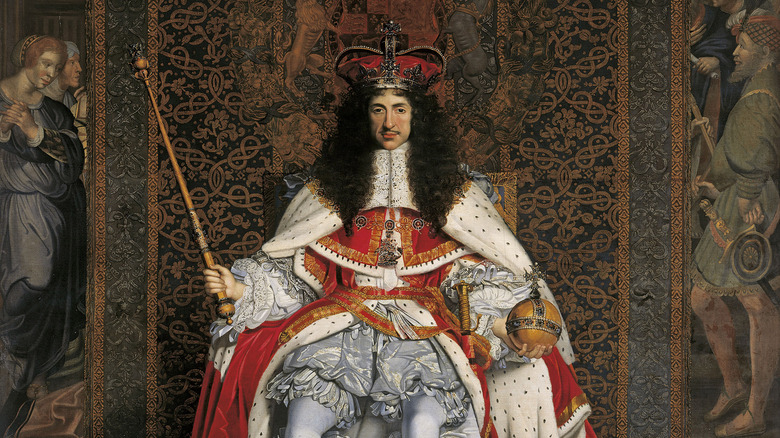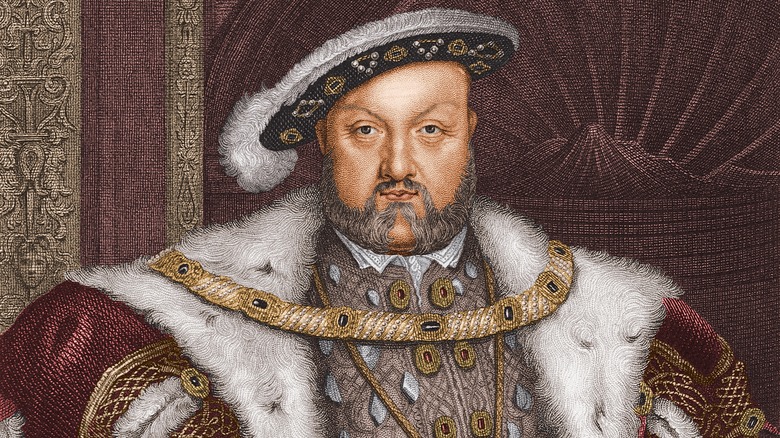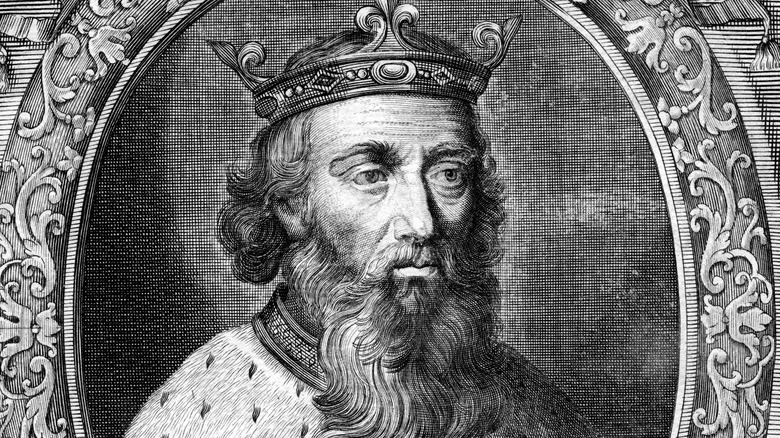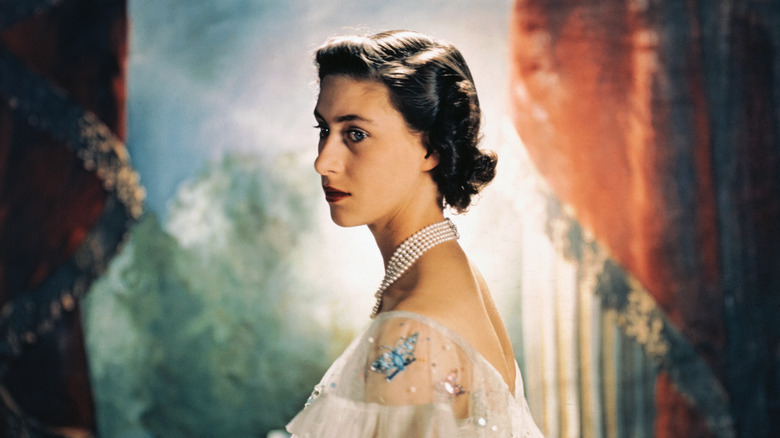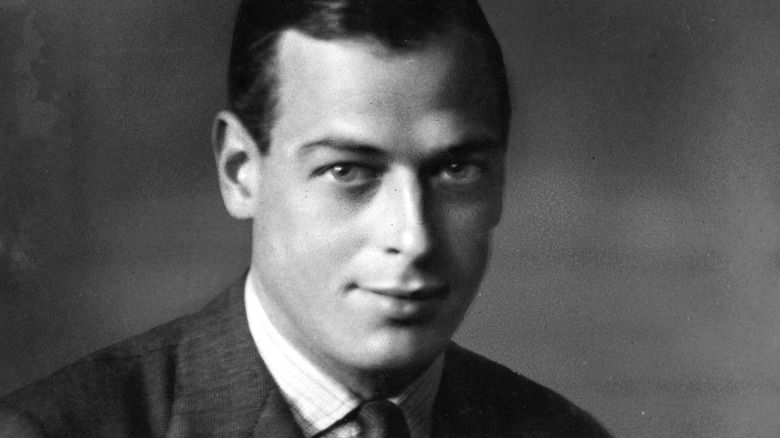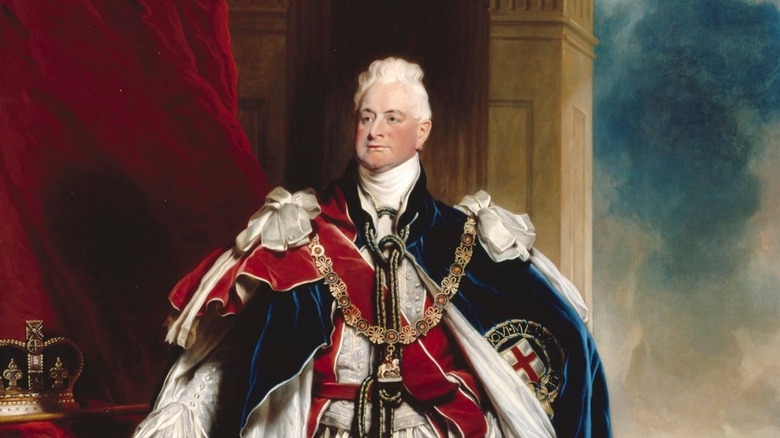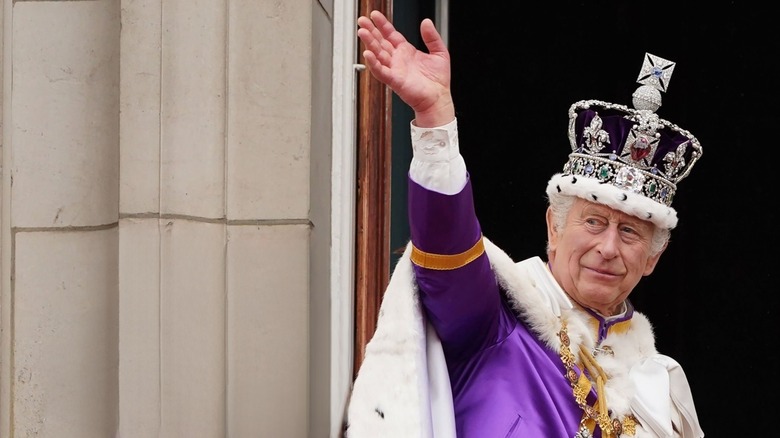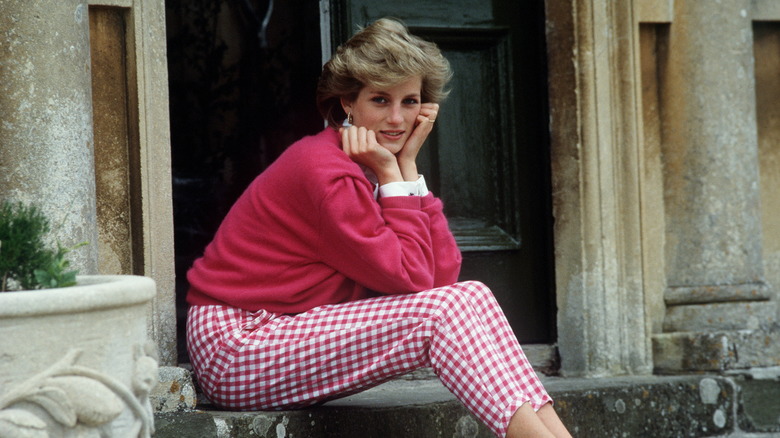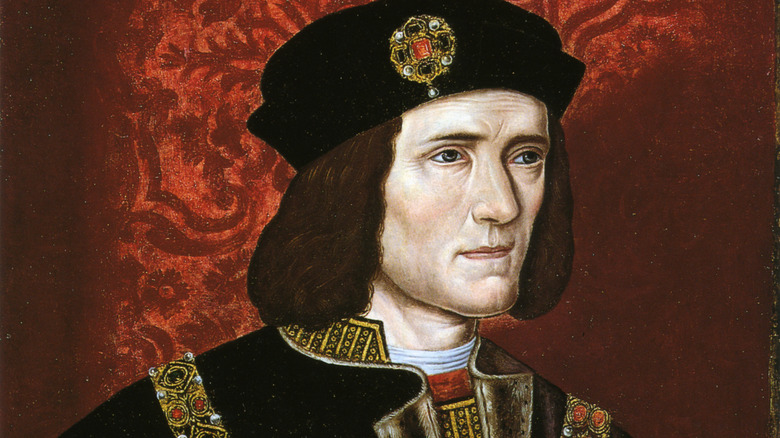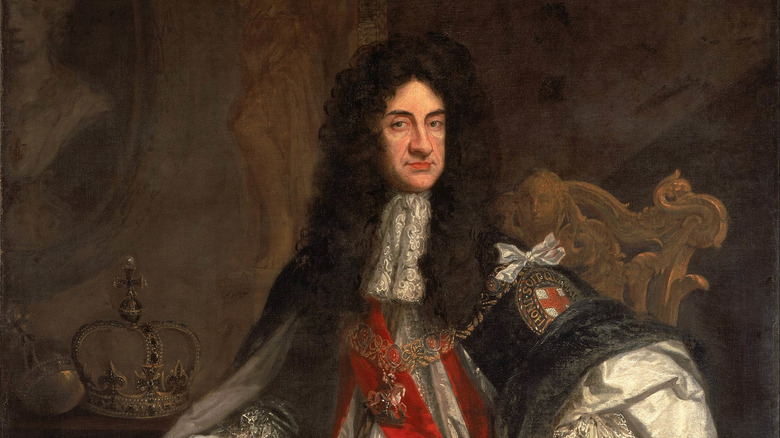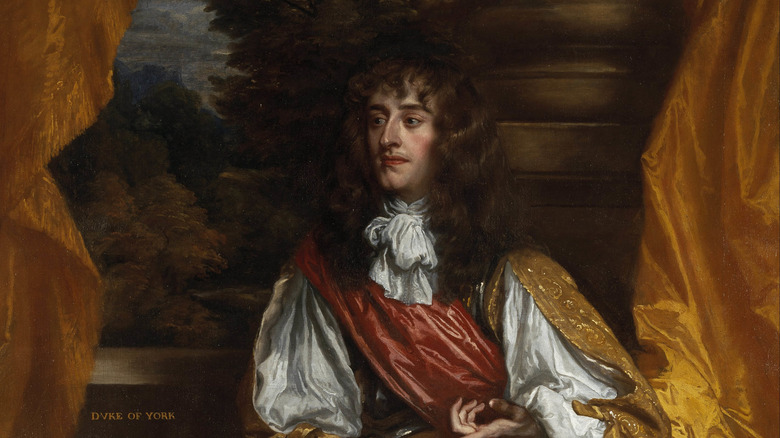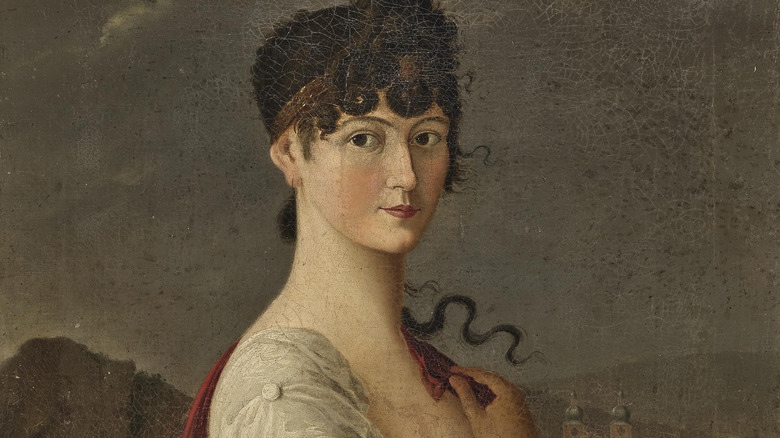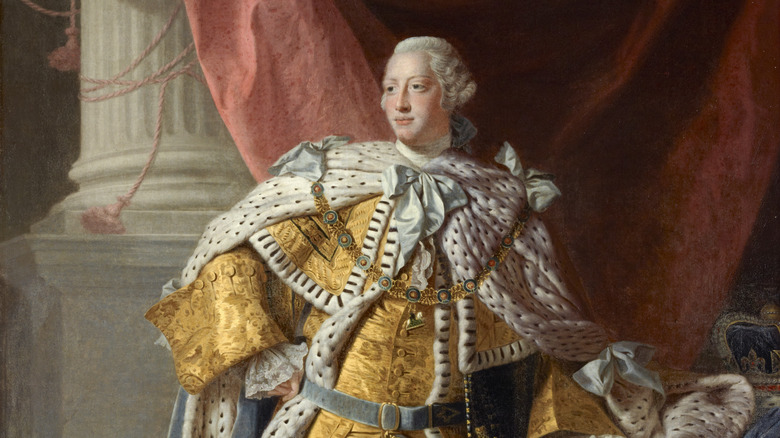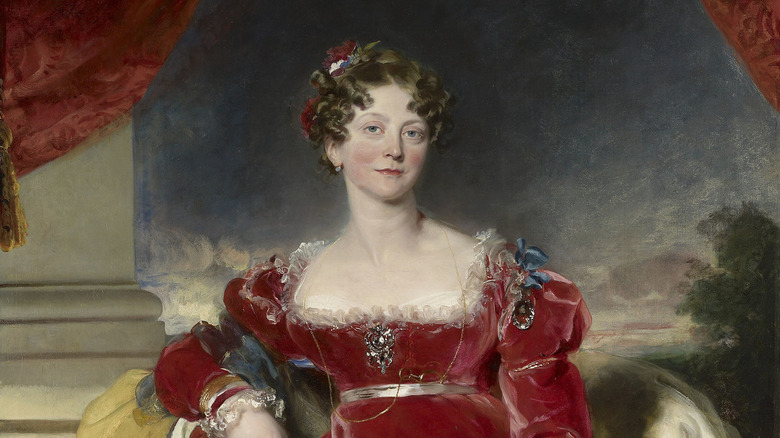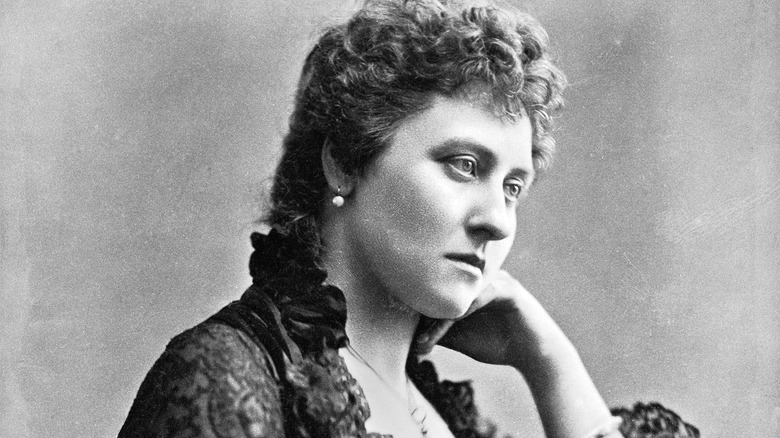British Royals With Rumored Illegitimate Children
Today, it may seem as if members of the British royal family have no privacy at all. They may have a portfolio of castles, designer clothes, and other glamorous possessions, sure, but few other people are subject to the kind of intense public scrutiny that King Charles III and his family experience. Even the seemingly private matter of childbirth is up for public consumption here. Royal birth announcements can be written up in fancy type and placed on a stand right in front of waiting reporters, photographers, and other onlookers, while some new royal moms are expected to haul themselves out of bed and smile nicely for the press while cradling a newborn.
With all that hubbub, it may seem impossible for anything to get past the public, especially where babies are concerned. But that hasn't always been the case. Historically, kings, queens, and other British royals had the benefit of less media in their faces. Moreover, if you go far enough back in history, you'll find that it was practically expected of some rulers — who typically married for political and not romantic reasons — to have multiple mistresses and illegitimate children.
Considering this, it's no surprise that there are many rumors of concealed illegitimate children attached to members of Britain's royal family. Even modern rulers might have a surprise or two in their pasts, though many of these tales remain solidly in the realm of speculation.
Henry VIII
It's hard to pick the most infamous king in British history, but the Tudor-era Henry VIII is surely in the upper ranks of the nation's most poorly-behaved monarchs. Besides the sometimes sordid drama of his six consecutive wives (two of whom were beheaded at his order), Henry also upended his realm's religious beliefs for personal reasons. He broke from the Catholic Church and formed the Church of England when the pope refused to annul Henry's first marriage to Katherine of Aragon.
Henry openly acknowledged one illegitimate son, a boy who came to be known as Henry FitzRoy. The son of courtier Elizabeth Blount, young Henry was sometimes seen as a bit of a blessing, as he confirmed that the king was capable of producing a son in the years-long quest for a legitimate royal heir, to the point where "Bless 'ee, Bessie Blount" reportedly became a popular saying at the time. But FitzRoy was out of the line of succession, leaving Henry to his succession of wives in an attempt to produce a son who could take the throne.
However, tales abound that the king didn't stop at Bessie Blount when it came to fathering children out of wedlock. Unproven rumors maintain that he was the biological father of former mistress Mary Boleyn's children, Henry and Catherine Carey. Awkwardly enough, Mary was the sister of Henry's second wife, Anne Boleyn. Other supposed children of the king included Thomas Stukeley, Richard Edwardes, Ethelreda Malte, and John Perrot.
Henry I
Going by the numbers, the 12th-century English ruler Henry I could have the most illegitimate children of all British monarchs. According to historians, he had more than 20 acknowledged illegitimate children, who sometimes proved to be useful allies when given decent titles, strategic posts, and key marriages. He only ever produced one legitimate daughter, Empress Matilda, who tried and failed to claim the throne in the wake of her father's death.
However, medieval records being so unclear, it's not always obvious who was fathered by Henry I and with what consorts. Some have argued that the children of a Welsh princess named Nesta were fathered by the English king, though other sources point out that she likely had children by three other men (including her husband, a castle constable). This and other purported children could have been the result of wishful thinking, however, as some may have wanted there to be a more clear connection (and political alliance) between the king and other political figures in the realm.
In general, it appears that Henry I wasn't shy about hooking up with the wives, daughters, or other female relatives of his high-ranking subjects. Ultimately, he may have simply made a move on whoever was nearby and convenient, at least stepping up in multiple cases to make the resulting children nobles of various ranks. Still, given his pattern of behavior, it's reasonable to think that there were far more than 20 little Henrys toddling about the kingdom in his wake.
Princess Margaret
Elizabeth II's sister, Princess Margaret, proved herself to be something of a wild child early on. Even though she was the daughter of George VI and the sister of the queen, she didn't always behave like the buttoned-up royals around her. She wasn't afraid to spend money like it was going out of style, drank and smoked profusely, and was notorious for a sharp and often biting wit. Margaret also reportedly attracted the attention of famous would-be lovers, from Mick Jagger to Picasso, though little of her romantic goings-on have been proven.
There is also one especially salacious rumor regarding Margaret's children. No, not her children with ex-husband Antony Armstrong-Jones, David Armstrong-Jones and Lady Sarah Chatto. Robert Brown claims that he is actually the oldest child of Princess Margaret, conceived with RAF officer and Margaret's former paramour, Group Captain Peter Townsend. Supposedly, his divorced status was what kept them from marrying (the 16-year age difference between him and the young princess probably didn't help, either).
Brown has made the case that he was born to the pair in 1955 but, seeing as his existence would have proven supremely controversial even for the rebellious princess, he claims that he was raised by Cynthia and Douglas Brown instead. Brown has brought his case before Britain's courts, claiming that the information proving his true familial relations is in the sealed royal wills. However, though he won some legal recognition, no smoking gun has come to light as of this writing.
Prince George, Duke of Kent
As the younger brother of kings Edward VIII and George VI, and uncle to Elizabeth II, Prince George, Duke of Kent was close to the highest echelons of royal power and a fixture of the British social circuit. He was also apparently quite scandalous, not only allegedly carrying on affairs with men and women, but purportedly acquiring and then kicking a drug habit. George also served in the Royal Navy, worked in the Foreign and Home Offices, and served in the Royal Air Force. It came to an abrupt end on August 25, 1942, when the 39-year-old George and 14 others died in an airplane crash.
The Duke's glamorous, sometimes sordid lifestyle generated many rumors, including at least two different stories of secret children. Some claimed that he was the father of American diplomat Michael Temple Canfield, whose alleged mother was American socialite Kiki Preston. Canfield married Lee Bouvier, sister of Jacqueline Kennedy Onassis, though their marriage was later annulled.
Perhaps even more colorful is the rumor that the Duke of Kent fathered a child with none other than romance novelist Dame Barbara Cartland. She reportedly claimed to have had an encounter with the 25-year-old Duke that produced her daughter, Raine. Or perhaps that was wishful thinking on Cartland's part, as her marriage to her first husband — the legally recognized father of Raine — ended poorly. Raine went on to become a socialite and, most notoriously, the stepmother of Diana, Princess of Wales.
William IV
Though William IV never produced a living legitimate heir (paving the way for his niece Victoria to take the throne), he very definitely had the ability to produce children. After a youth spent romancing pretty ladies and generally carousing about, he kind of settled down with actress Dorothea Jordan in 1790. Over the course of their roughly 20-year relationship, the two never officially married because of her status as a commoner. Her rank made Jordan ineligible to marry the then-Duke of Clarence thanks to the Royal Marriages Act of 1772. Still, that wasn't much of an impediment to the pair, who ultimately had 10 children together. Willliam eventually dumped her to seek out a legitimate wife.
William IV commissioned a statue of Jordan in 1831, but seeing as she had died destitute in 1816, it was a pretty empty gesture that probably didn't put the king's wife, Adelaide of Saxe-Meinengen, in a happy state of mind. As for the children produced via his legitimate marriage, William and Adelaide had five children. Tragically, however, all died either at birth or within only a few months.
At least William acknowledged the children he had with Jordan. Yet, though there are no clear records or tales of any more children born out of wedlock to William IV, it's no stretch to imagine that a fun-loving monarch who once bore the nicknames of the "sailor king" and "Silly Billy" might have had some long-lost children carrying his genes, if not his titles.
Charles III
Being the current monarch of the United Kingdom doesn't offer much protection from scandal, as King Charles III can tell you. Even as the Prince of Wales, a title that he held for more than 60 years, he faced all manner of ups and downs in the British press. For many, Charles has made it through the most dramatic period of life as a royal, including the public failure of his marriage to Diana, Princess of Wales. Besides being king, he's also been married to Camilla Parker Bowles since 2005 and made her Queen Consort upon his own accession. Yet, rumors still dog him. One man, Simon Charles Dorante-Day, claims that he is the secret love child of Charles and Camilla, conceived long before the two had settled into married life.
According to Dorante-Day, he is the product of a 1965 union between a teenage Charles and Camilla. As he told the Australian tabloid New Idea, his grandmother claimed that he was the pair's child. He states that Camilla is absent from the public record for enough time to have concealed a pregnancy and claims to remember meeting with a mysterious woman who looked like Camilla.
Too bad Dorante-Day hasn't produced any evidence to back up his claims, while the king isn't agreeing to a DNA test with someone who may just be a random pretender. Moreover, the timelines don't quite add up, as the royal pair don't appear to have started their relationship until the 1980s.
Princess Diana
By the 1980s, it was painfully clear to many observers that the marriage of Princess Diana and Prince Charles was all but over. The pair had only been married since July 1981 and had their first child nearly a year later, but by 1986, it appears that both Charles and Diana had stepped out on their marriage. Charles had gotten back into a relationship with former flame (and future second wife) Camilla Parker Bowles, while Diana turned to army captain and horse riding teacher James Hewitt. The increasingly unhappy royal couple finally separated in late 1992 and officially divorced in 1996.
By that point, Diana's affair with Hewitt had been over for at least four years, but their brief relationship would come back to haunt Diana's legacy even after her sudden death in a 1997 car accident. It wasn't just that Hewitt garnered widespread boos for trying to sell Diana's love letters in the early 2000s. There was also the matter of Prince Harry, whom some onlookers began to claim bore a striking resemblance to the ginger-haired Hewitt.
Of course, that's hardly proof of anything. In fact, it all falls apart when you simply look at the dates. Prince Harry was born in 1984, well before Diana and Hewitt came into any sort of contact. Harry noted as such in his 2023 memoir, "Spare," where he also claimed that Charles would occasionally make hurtful jokes that he might not be Harry's real father (via Cosmopolitan).
Richard III
Like many medieval rulers, Richard III had multiple illegitimate children. His eldest known son, typically referred to as John of Gloucester, was made a captain and perhaps even knighted in September 1483, though it's difficult to pick the details out from a patchy historical record. However, John of Gloucester is specifically referred to in one instance as the king's "base son," while a later grant written in Richard's voice speaks of "our dear bastard son" (via the Richard III Society). Not long after, an illegitimate daughter, Katherine Plantagenet, pops up in documents, though it's not clear exactly how old she was at the time.
Though Richard III doesn't appear to have produced any more illegitimate children after his marriage to Anne Neville in 1472, there remains one more possible child that came into being before their union. Often referred to as Richard Plantagenet, or sometimes Richard of Eastwell, the only record that appears to refer to him is a simple line noting his 1550 burial in Eastwell. Some accounts claim that the line also includes a special mark denoting a noble, but that appears to be a story crafted in the 18th century. Other 1700s-era details include the legend that Richard III acknowledged his other illegitimate son just before his own doom at the Battle of Bosworth and that Richard Plantagenet lived out his life as a simple stonemason. However, fascinating as such a rumor may be, no one's found definitive proof of a long-lost son of Richard III.
Charles II
Though medieval kings like Henry I might hold the dubious honor of most illegitimate children (that we know of), it could be hard for them to match the freewheeling, downright hedonistic lifestyle of the 17th-century Charles II. Perhaps we should give him a bit of a break, as his father, Charles I, was beheaded on the order of fun-hating rebel leader Oliver Cromwell. When he returned from exile at the age of 30, Charles II took part in a grand coronation in 1661. He also took a politically convenient wife, Catherine of Braganza, but it is clear that his passion was reserved for his multiple mistresses.
Charles had 14 known illegitimate children with seven different mistresses, though he failed to produce a legitimate heir with his wife and the throne went to the king's brother, James, upon Charles' death in 1685.
One legend claims that there was another son named James de la Cloche, who was said to have been conceived when the king was only a teenager. His parentage was supposedly only revealed after Charles II's death — odd indeed for a man who readily gave his other natural children titles. James de la Cloche also reportedly became a Jesuit priest and may have even been the famous Man in the Iron Mask. Too bad no one's been able to prove anything so exciting about this alleged child of the king, who may have simply been played by one or more imposters just looking for a good payout.
James II
Like so many other British kings, James II wasn't too worried about monogamy. He produced children with multiple mistresses, as usual. Meanwhile, his Catholic faith made enough people nervous that he was forced off the throne in favor of his legitimate Protestant daughter, Mary. With her Dutch husband, William, Mary co-ruled England from 1689 until her death in 1694.
The bevy of James' illegitimate children isn't terribly exciting, compared to other rulers. What is interesting, however, are the tales of one woman who was presented as another of the king's progeny after her death. That would be Jane Stuart, a Quaker woman who was supposedly born in Paris in 1654 while the future king was in exile from the anti-monarchist government of Oliver Cromwell. As the story goes, she was a lady in waiting to the queen, though she's missing from the record. The rest of her life reads like a soap opera, with a tragically killed lover, a period of poverty, and persecution for her newfound Quaker beliefs. It's said that she eventually became a simple laborer in the English countryside who couldn't help but leave some clues as to her origins, like the ability to read the Bible in Greek.
Cool story, but the details don't quite line up. James II acknowledged his other illegitimate children, so why not Jane? It's also telling that her story doesn't have much substantiation in records but instead has moved through history in the form of whispered rumors.
Princess Victoria
Though you would probably get laughed out of a history conference now for raising this notion, it was once proposed that none other than Queen Victoria was a product of extramarital hanky-panky. Yes, that Queen Victoria. As rumor would have it, her mother, Princess Victoria of Saxe-Coburg-Saalfeld, had an affair with Irish military officer John Conroy, who was assigned to the household of Edward, Duke of Kent, the future queen's ostensible father. Some claimed that Conroy and the elder Victoria were a bit too close for comfort. Conroy reportedly acted pretty familiarly with the princess and their daughter and attempted to isolate them and gain control after it became clear that the younger Victoria was set to be queen. Or was that just malicious gossip promulgated by Baroness Lehzen, Queen Victoria's governess and close friend who had her own complicated relationship with the royal household?
Then again, young Victoria herself vaguely admitted to an untoward closeness between her mother and Conroy, while onlookers like the Duke of Wellington couldn't help but speculate. Modern historian A.N. Wilson added fuel to the fire by claiming that Conroy was the source of the hemophilia gene that plagued some of Queen Victoria's descendants (via Royal Central). Only now Wilson has admitted that the medical evidence is shaky and that, besides his claim that a bug-eyed Victoria bears a resemblance to earlier British rulers from the House of Hanover, hemophilia could have arisen without genetic interference from Conroy.
George III
Historian A.N. Wilson admitted that his theory of an illegitimate Queen Victoria could be wrong in part because he spotted a resemblance between Victoria and George III. But could George, who infamously saw the loss of valuable overseas colonies in the American Revolution and suffered from debilitating bouts of mental instability, have secret children of his own? So said Father Robert Carroon, an archivist who, in 1993, confidently told The New York Times that George III had four children with a mistress named Hannah Lightfoot. Carroon even claimed to have met a probable descendant who held an uncanny resemblance to the long-dead king.
But a closer look at the story of Hannah Lightfoot casts doubt on the whole notion. Genealogist Anthony J. Camp notes that Hannah Lightfoot appears to have been a real Quaker woman and there were contemporary rumors of a mysterious "Fair Quaker" in the king's company. One woman, Lavinia Ryves, even claimed that the king had married Lightfoot years earlier and so invalidated his marriage to Queen Charlotte. That made their 15 children illegitimate and left the throne open to the true heir — conveniently, Lavinia herself.
However, there's no real evidence connecting Lightfoot and George III. It doesn't help that, at the time he would have supposedly met her, George was a notoriously shy young man who lived in the shadow of his powerful, bickering family. Moreover, Lavinia and her mother, Olive Serres, presented more compelling evidence that they were con artists than long-lost relatives.
Princess Sophia
Being a daughter of George III was a tough deal. Sure, you would have been fantastically rich compared to many, many other people in the kingdom, but your father would have suffered through very public trials with his physical and mental health. Moreover, the heir apparent and your brother, the future George IV, was an increasingly unpopular ruler-to-be thanks in large part to his decadent lifestyle. Things weren't much better for Princess Sophia, the fifth daughter of George III and Queen Charlotte. She spent much of her life blandly hanging around the royal family and never marrying, but rumors of an illegitimate son dogged her from the earliest years of the 19th century.
The rumor mill claimed that Princess Sophia had a son with military officer and royal aide Major General Thomas Garth in 1800 or perhaps late 1799. Some even went so far as to claim that the two, who appear to have grown close in the 1790s, were married after a fashion, though it couldn't have been legal due to the Royal Marriages Act that restricted Sophia's official husband candidates. But Garth does appear to have raised a rather mysterious boy named Tommy, who not only became the elder Garth's heir but took on a similar military career of his own. But, like so many tales of royal whoops babies (and perhaps especially those born to unmarried princesses), no one's ever produced incontrovertible proof that Princess Sophia really gave birth to Major General Garth's adopted heir.
Princess Louise
As much as Queen Victoria may have wanted to uphold an image as a loving mother and doting wife, the reality is that her family had quite a few scandalous members. There was the heir, who earned the nicknames of the Playboy Prince and Dirty Bertie before he became Edward VII. And it would be hard to forget Victoria's predecessor and uncle, William IV, who conceived 10 children with a mistress but produced no living heirs with his royal wife.
Victoria probably also lost sleep over her daughter Louise, who grew up to be a popular princess. That wasn't so bad, but the rumors that she had secretly carried an illegitimate child likely didn't ease her oftentimes conservative mother's mind. Supposedly, the princess conceived a child in the 1860s with her brother Leopold's tutor, a man named Walter Stirling. As historian Lucinda Hawksley told Today (via The Independent), Stirling lasted a mere four months with the royal family but was given a regular payout even after he was fired.
Around the same time, a boy named Henry was born and swiftly adopted into the family of someone very close to the Queen — royal gynecologist Sir Charles Locock. Henry's descendants claim a physical resemblance to Victoria's family, but DNA tests haven't happened yet to provide clear evidence either way. And, as Hawksley told the CBC, Louise's documents in the Royal Archives are closed, hinting that there may be something in there that could illuminate the rumors.
